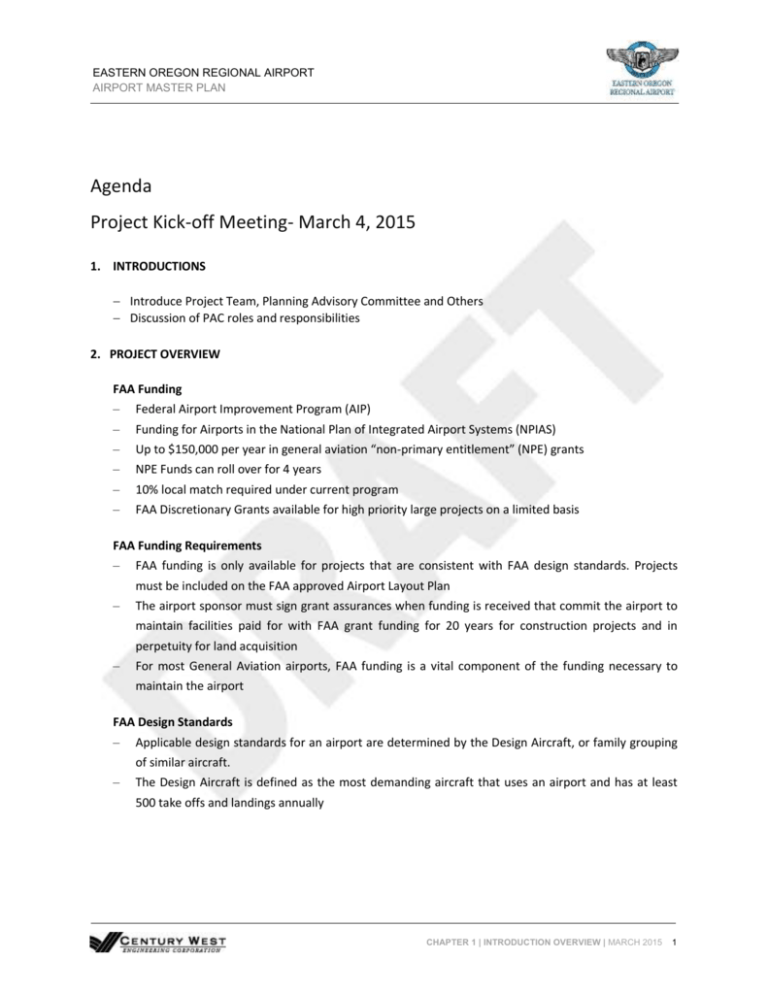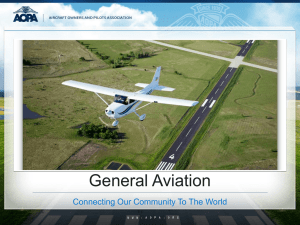Agenda - Century West Engineering
advertisement

EASTERN OREGON REGIONAL AIRPORT AIRPORT MASTER PLAN Agenda Project Kick-off Meeting- March 4, 2015 1. INTRODUCTIONS Introduce Project Team, Planning Advisory Committee and Others Discussion of PAC roles and responsibilities 2. PROJECT OVERVIEW FAA Funding – Federal Airport Improvement Program (AIP) – Funding for Airports in the National Plan of Integrated Airport Systems (NPIAS) – Up to $150,000 per year in general aviation “non-primary entitlement” (NPE) grants – NPE Funds can roll over for 4 years – 10% local match required under current program – FAA Discretionary Grants available for high priority large projects on a limited basis FAA Funding Requirements – FAA funding is only available for projects that are consistent with FAA design standards. Projects must be included on the FAA approved Airport Layout Plan – The airport sponsor must sign grant assurances when funding is received that commit the airport to maintain facilities paid for with FAA grant funding for 20 years for construction projects and in perpetuity for land acquisition – For most General Aviation airports, FAA funding is a vital component of the funding necessary to maintain the airport FAA Design Standards – Applicable design standards for an airport are determined by the Design Aircraft, or family grouping of similar aircraft. – The Design Aircraft is defined as the most demanding aircraft that uses an airport and has at least 500 take offs and landings annually CHAPTER 1 | INTRODUCTION OVERVIEW | MARCH 2015 1 EASTERN OREGON REGIONAL AIRPORT AIRPORT MASTER PLAN KEY WORK ELEMENTS: – Inventory of Existing Conditions and Activity – Airport Land Use & Market Analysis – Aviation Activity Forecasts – Define Planning Assumptions (design aircraft, etc.) – Demand-Capacity & Facility Requirements Analyses – Identify and Evaluate Development Alternatives – Define Preferred Alternative – Environmental Review – Prepare 20-Year Airport Capital Improvement Program – Prepare Airport Layout Plan Drawing Set – UAS Analysis – AGIS Survey – Wildlife Study Inventory- document and evaluate existing facilities and conditions Forecasts - define current activity and project future aviation activity over the twenty-year planning period: – Based Aircraft – Aircraft Operations – Design Aircraft (Current/Future) – Specific Activity Breakdowns (Peaking, Aircraft Fleet Mix, etc.) – Commercial Activity Facility Requirements Analysis– define current and future airport facility needs based on selected aviation activity forecast for the twenty-year planning period: – Airside (runway, taxiway, lighting, etc.) – Landside (aircraft parking, hangar, aircraft fueling, fixed base operator, etc.) – Navigational Aids and Weather – Support (utilities, surface access, vehicle parking, etc.) Airport Development Alternatives- create options for developing new facilities to meet forecast demand and facility requirements: – Prepare and Present Draft Preliminary Options – Public and Planning Advisory Committee Review – Refine Option Elements Based on Input – Prepare and Present Preliminary Preferred Alternative – Public and Technical Advisory Committee Review – Additional Refinement (as needed) MEETING AGENDA MARCH 4, 2015 - 2 EASTERN OREGON REGIONAL AIRPORT AIRPORT MASTER PLAN Desired Outcomes – Maintain the airport's current aeronautical capabilities and accommodate future needs, while meeting FAA standards. – Create an effective improvement program that establishes clear priorities that are financially feasible – Upgrade airport capabilities based on safety needs, technology, etc. – Minimize impacts on surrounding property owners and neighbors 3. DISCUSSION OF KEY ISSUES SPECIFIC TO THE EASTERN OREGON REGIONAL AIRPORT Development Needs – Runway, Taxiway Improvements/Maintenance – Terminal areas/Terminal Building – Aircraft Parking Apron, Hangar Space (T-hangars, individual hangars, commercial hangars) – Corporate Aviation Services – Commercial Air Carrier Analysis – Airport Security – Vehicle Parking – FBO Facilities – Aircraft Fuel Storage Areas – Airfield Lighting, Runway Markings, Signage – Instrument Approach – Utilities, Fire Protection – Snow Removal Equipment and Structures – Stormwater Drainage System Requirements – Aviation and Non-Aviation Land Requirements – FAR Part 139 assessment (related to potential future airport commercial air service) – Unmanned Aerial Systems Test Range Airside and Landside Facility Needs Key FAA Design Standards – Runway Length – Clear Approaches – Lateral Clearances – Runway Safety Area (RSA) – Object Free Area (OFA) – Obstacle Free Zone (OFZ) 4. NEXT STEPS - Next meeting end of May to discuss Aviation Activity Forecasts MEETING AGENDA MARCH 4, 2015 - 3







